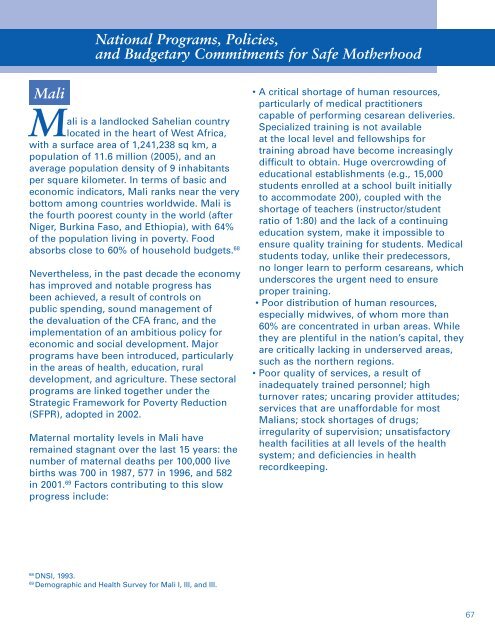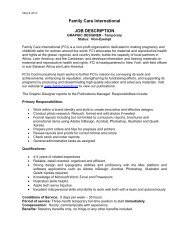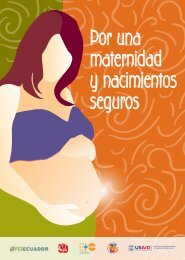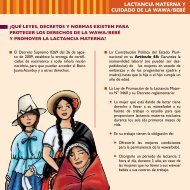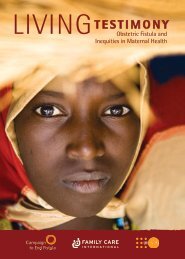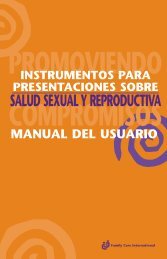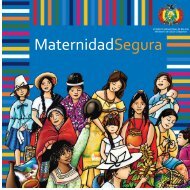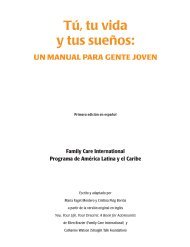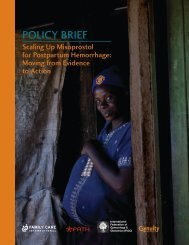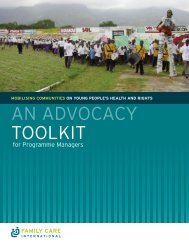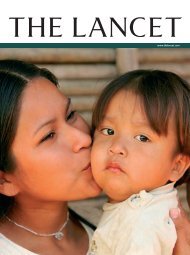Safe Motherhood: A Review - Family Care International
Safe Motherhood: A Review - Family Care International
Safe Motherhood: A Review - Family Care International
Create successful ePaper yourself
Turn your PDF publications into a flip-book with our unique Google optimized e-Paper software.
Mali<br />
National Programs, Policies,<br />
and Budgetary Commitments for <strong>Safe</strong> <strong>Motherhood</strong><br />
Mali is a landlocked Sahelian country<br />
located in the heart of West Africa,<br />
with a surface area of 1,241,238 sq km, a<br />
population of 11.6 million (2005), and an<br />
average population density of 9 inhabitants<br />
per square kilometer. In terms of basic and<br />
economic indicators, Mali ranks near the very<br />
bottom among countries worldwide. Mali is<br />
the fourth poorest county in the world (after<br />
Niger, Burkina Faso, and Ethiopia), with 64%<br />
of the population living in poverty. Food<br />
absorbs close to 60% of household budgets. 68<br />
Nevertheless, in the past decade the economy<br />
has improved and notable progress has<br />
been achieved, a result of controls on<br />
public spending, sound management of<br />
the devaluation of the CFA franc, and the<br />
implementation of an ambitious policy for<br />
economic and social development. Major<br />
programs have been introduced, particularly<br />
in the areas of health, education, rural<br />
development, and agriculture. These sectoral<br />
programs are linked together under the<br />
Strategic Framework for Poverty Reduction<br />
(SFPR), adopted in 2002.<br />
Maternal mortality levels in Mali have<br />
remained stagnant over the last 15 years: the<br />
number of maternal deaths per 100,000 live<br />
births was 700 in 1987, 577 in 1996, and 582<br />
in 2001. 69 Factors contributing to this slow<br />
progress include:<br />
68 DNSI, 1993.<br />
69 Demographic and Health Survey for Mali I, III, and III.<br />
• A critical shortage of human resources,<br />
particularly of medical practitioners<br />
capable of performing cesarean deliveries.<br />
Specialized training is not available<br />
at the local level and fellowships for<br />
training abroad have become increasingly<br />
difficult to obtain. Huge overcrowding of<br />
educational establishments (e.g., 15,000<br />
students enrolled at a school built initially<br />
to accommodate 200), coupled with the<br />
shortage of teachers (instructor/student<br />
ratio of 1:80) and the lack of a continuing<br />
education system, make it impossible to<br />
ensure quality training for students. Medical<br />
students today, unlike their predecessors,<br />
no longer learn to perform cesareans, which<br />
underscores the urgent need to ensure<br />
proper training.<br />
• Poor distribution of human resources,<br />
especially midwives, of whom more than<br />
60% are concentrated in urban areas. While<br />
they are plentiful in the nation’s capital, they<br />
are critically lacking in underserved areas,<br />
such as the northern regions.<br />
• Poor quality of services, a result of<br />
inadequately trained personnel; high<br />
turnover rates; uncaring provider attitudes;<br />
services that are unaffordable for most<br />
Malians; stock shortages of drugs;<br />
irregularity of supervision; unsatisfactory<br />
health facilities at all levels of the health<br />
system; and deficiencies in health<br />
recordkeeping.


